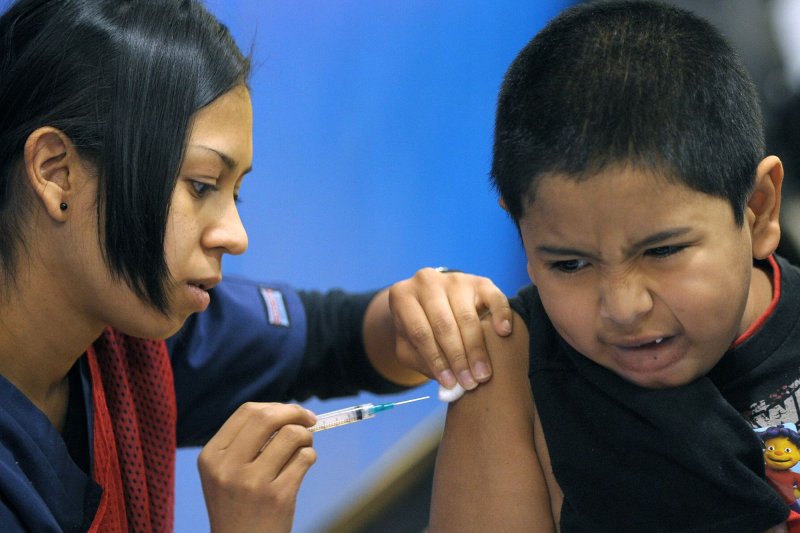A young boy receives a flu vaccine shot from a nurse at Carlin Springs Elementary School in Arlington, Virginia on Jan. 7, 2010. The CDC says this year's flu vaccine may be less effective because the predominant strain of the virus -- H3N2 -- drifted since the vaccine was created. File photo by Roger L. Wollenberg/UPI. |
License Photo
ATLANTA, Dec. 4 (UPI) -- The U.S. Centers for Disease Control and Prevention says the current flu season may be a particularly bad one and this year's vaccine may be less effective, to boot.
The health organization said so far in the 2014-15 flu season, H3N2 has been the most common, a concerning trend. The three most deadly flu seasons in the past 11 years -- 2012-13, 2007-08 and 2003-04 -- each featured H3N2 as the predominant strains.
H3N2 viruses are characterized as "moderately severe" by the CDC.
"It's too early to say for sure that this will be a severe flu season, but Americans should be prepared," CDC director Tom Frieden said in a statement released Thursday. "We can save lives with a three-pronged effort to fight the flu: vaccination, prompt treatment for people at high risk of complications, and preventive health measures, such as staying home when you're sick, to reduce flu spread."
Adding to the problem is that this year's flu vaccine doesn't fully cover H3N2.
Each year's flu vaccine is created to stop the three or four most common strains of the virus currently circulating. Since the 2014-15 vaccine was created, the predominant H3N2 variant changed slightly, or "drifted."
The vaccine will still protect against H3N2 to some degree, though, the CDC s ays. In the 2007-08 flu season, H3N2 drifted, but the vaccine still had an overall efficacy of 37 percent and 42 percent efficacy against H3N2.
"While the vaccine's ability to protect against drifted H3N2 viruses this season may be reduced, we are still strongly recommending vaccination," said Joseph Bresee, M.D., Chief of the Influenza Epidemiology and Prevention Branch at CDC. "Vaccination has been found to provide some protection against drifted viruses in past seasons. Also, vaccination will offer protection against other flu viruses that may become more common later in the season."
Flu activity is currently low in the United States, but it's not too late to get vaccinated. Those at high risk for serious complications from the virus are children younger than 5 years old, adults over the age of 65, pregnant women and those with chronic health conditions.
The CDC recommends these high-risk patients should immediately take antiviral drugs like Tamiflu and Relenza if flu symptoms appear, and not wait for lab tests to confirm flu infection.
Flu symptoms include fever, cough, sore throat, runny or stuff nose, body aches, headache, chills, and fatigue.
Earlier this year, a CDC report said more than 100 children died of the flu during the 2013-14 season, 99 of whom were unvaccinated.















